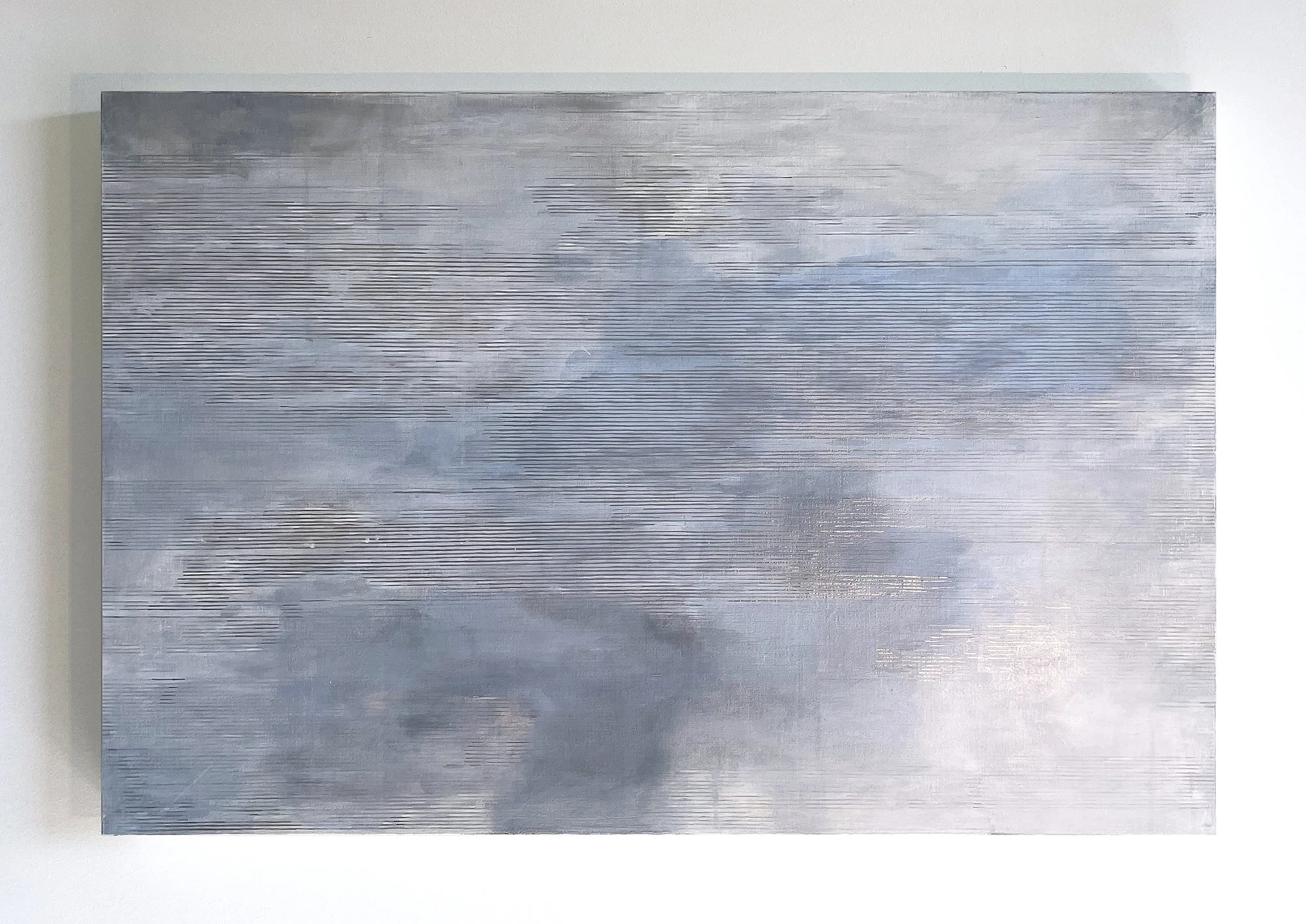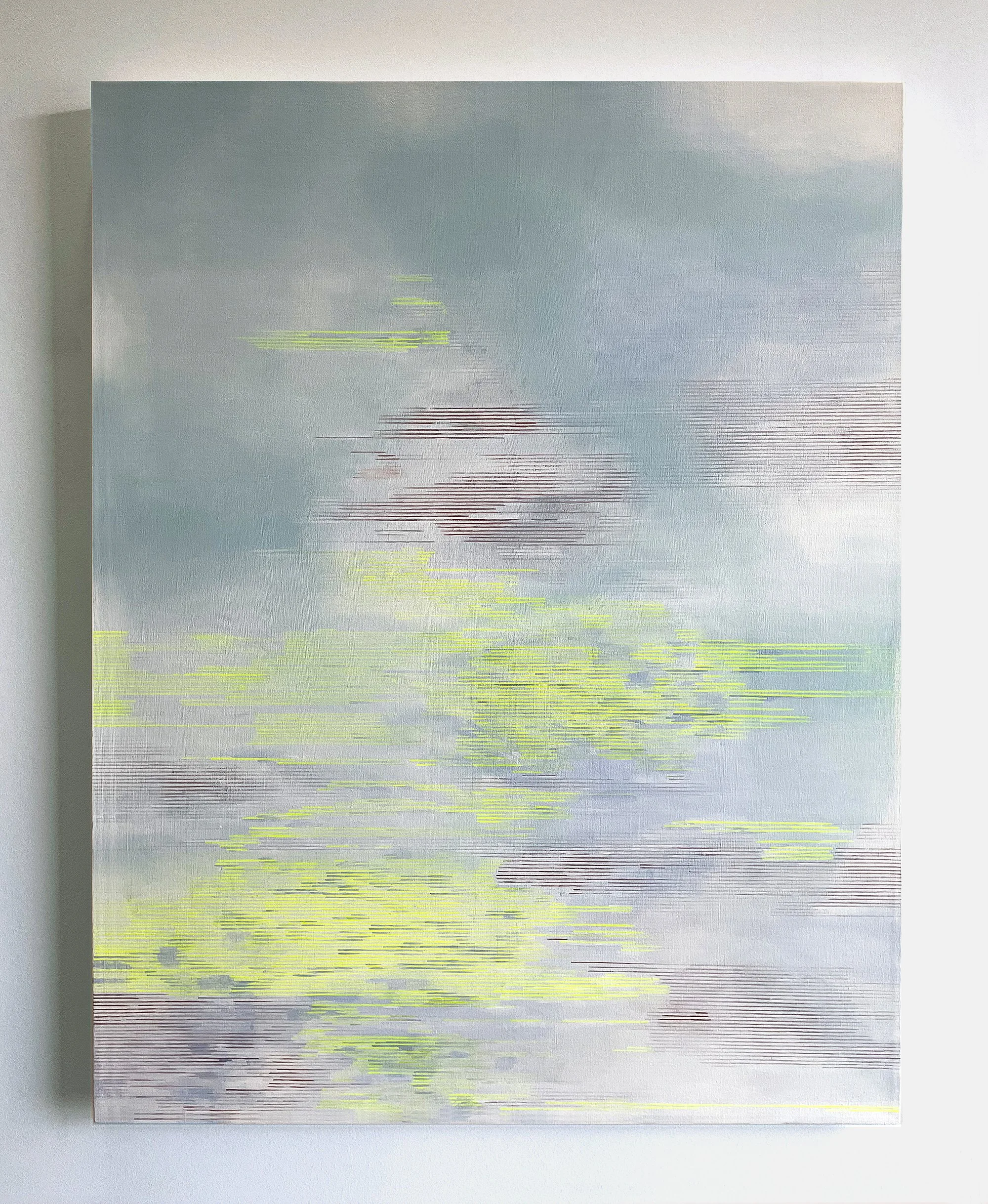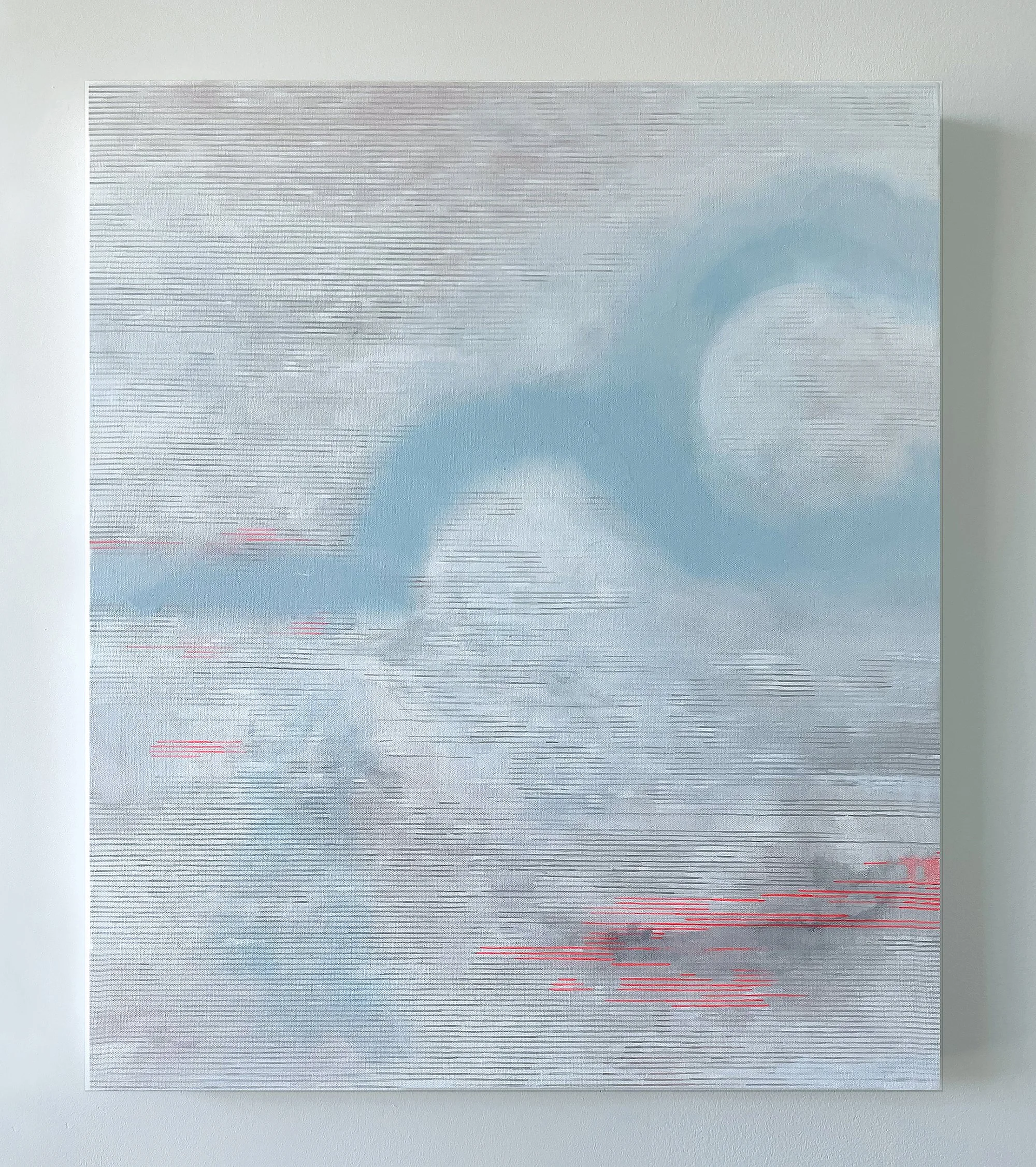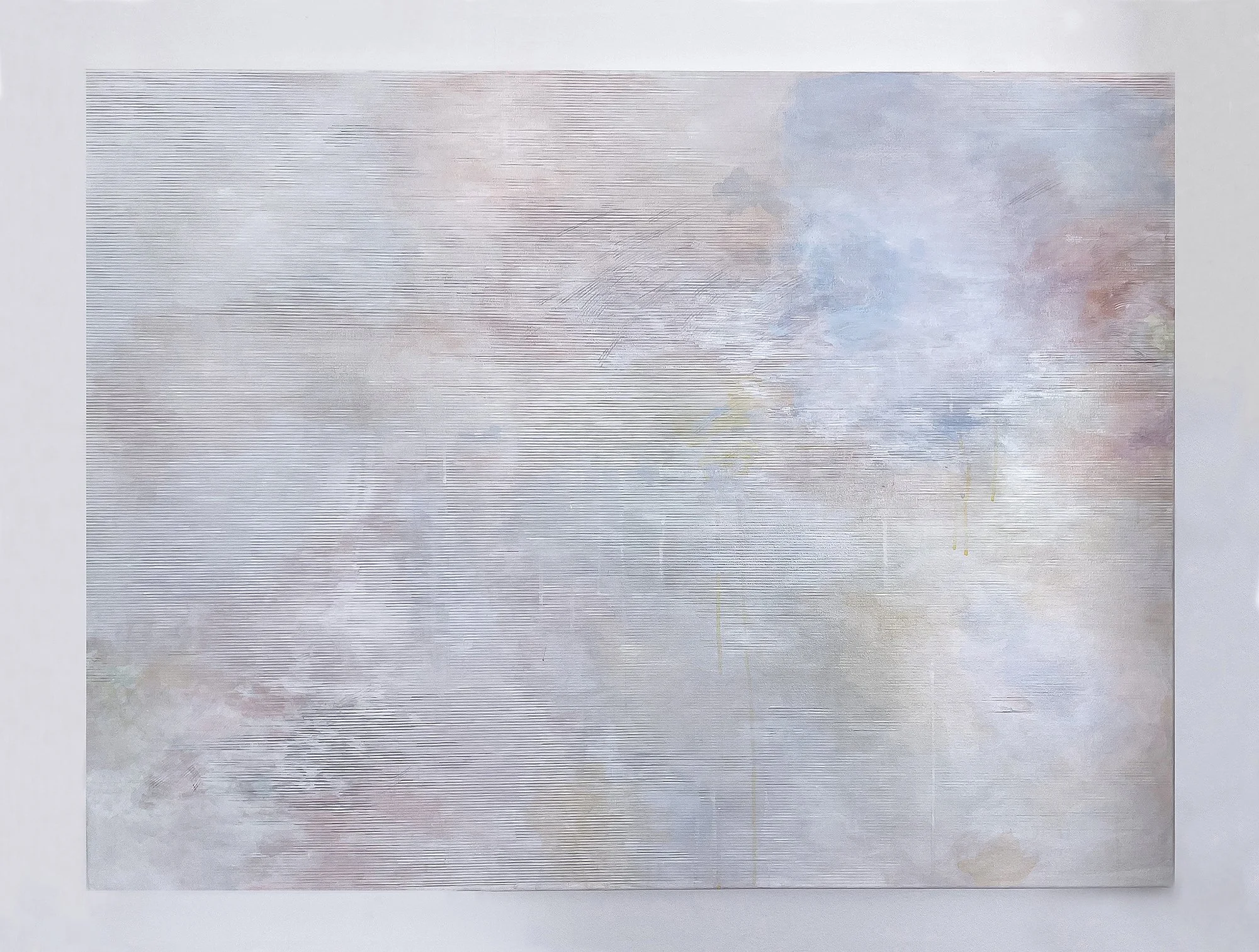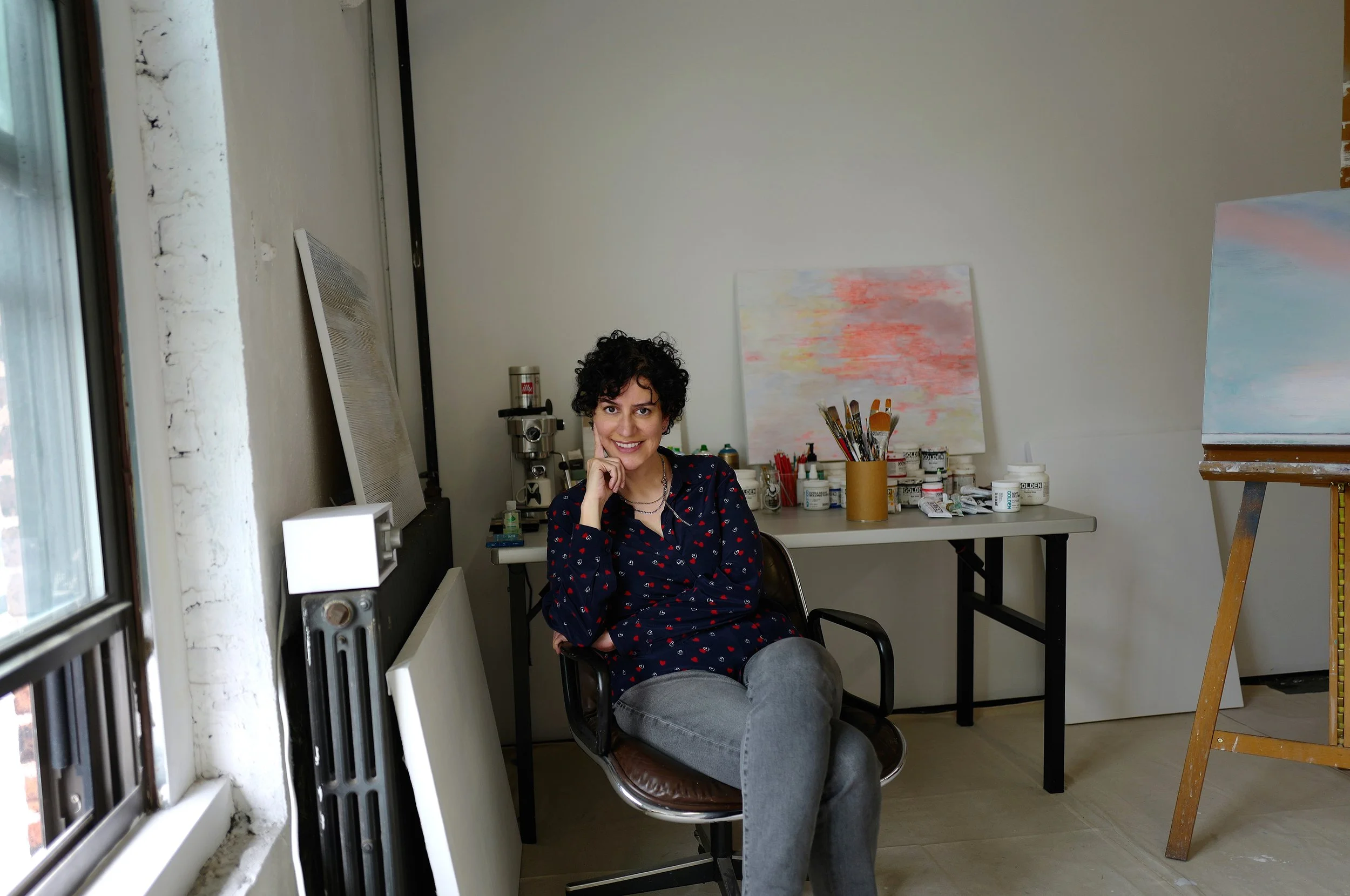A Culture of Poetry: Zahra Pars
Extremely Handsome, Extremely Useless, 2021
Acrylic, charcoal, and thread on linen over wood panel
24 x 36 in
My paintings are inspired by my Iranian heritage and “western” contemporary art. The ephemerality of beauty is a subject that I investigate through my art. In my approach to painting, I counter-balance minimalist restraint with detailed, repetitive brush-strokes. My paintings explore contrasts: East versus West, moderation versus excess, and handmade versus machine made. The labor intensiveness and minuteness of my work is influenced by Persian miniature painting, calligraphy, and weaving practices in the East and Latin America. As an immigrant from an authoritarian country, I am acutely aware of what can and cannot be said, and I see my paintings as a refuge of sorts, a place where I can create a new language. I describe my images as white noise—a blackout of overt meaning and the visualization of sound through light and color.
Welcome Zahra! Can you introduce yourself?
I was born in Tehran, Iran, and my family immigrated to the United States when I was quite young as a result of the Islamic Revolution in Iran. I grew up between California and Massachusetts in a household that was very culturally attuned to our Iranian heritage. There were Persian rugs throughout our home, and my father in particular was very interested in Persian calligraphy and poetry. Both my parents encouraged me to make art, and perhaps because I come from a culture that has a tradition of miniature painting and calligraphy, I was instructed to be quite deliberate and precise in my artistic pursuits as a child. For better or worse, I was always expected to color inside the lines, and this degree of precision is something that still translates into my current work. I received my Bachelor’s of Arts in art history and the practice of art from the University of California at Berkeley. After graduating, I worked in architecture and graphic design for a period of time, and later took graduate courses at the Institute of Fine Arts at New York University.
And where are you now?
Currently I live in Brooklyn New York where I have an art studio in the Brooklyn Navy Yard. I am primarily an abstract painter who works in acrylic, but I also incorporate spray paint, charcoal, and thread in my canvases. My canvases appear minimal at first, but they are in fact composed of a multitude of detailed horizontal brushstrokes. I love minimalism, but because of the degree of detail in my work, I would never dare call myself a minimalist.
Atlantis Never Existed, 2022
Acrylic, charcoal, and spray paint on canvas over wood panel
24 x 20 in
You describe your practice as labor intensiveness and minuteness that is influenced by Persian miniature painting, calligraphy, and weaving practices in the East and Latin America. Can you share more about how you approach repetition and changes of light?
My paintings are quite labor intensive and time consuming in part because I choose to paint with very small brushes, and am continually refining my line work so that at first it almost looks like it may have been created digitally, rather than by hand.
I am inspired by tapestries from Iran and Latin America, and when it comes to my own paintings, I feel that the minuteness of my brushstrokes and the uniform nature of the way I work has a kinship with weaving. I don’t literally incorporate weaving into my work, but I do add occasional pieces of thread on my canvases in a manner that mimics the lines I paint. I lived in Mexico from 2014 through 2016, and I was quite awestruck by the beauty and technicality of the textiles that are created in Oaxaca and Chiapas. And while I am not a textile artist, I admire the ability to work repetitively in detail over long periods of time, and this is something that I definitely share an affinity for in my painting practice.
I paint with subtle yet multiple layers of metallic and fluorescent color on a largely white background, my paintings continually reflect and deflect changes in light, and this adds a degree of impermanence and uncertainty to my work. These changes in light add an ephemeral quality to my canvases insofar as they never appear quite static.
When I first started painting in this way, I imagined my canvases as a blank page with lines on it, and I essentially sought to recreate a landscape of lined notebook paper. I view the horizontal lines I paint as a metaphor for language, and for me, they allude to how meaning can be both conveyed and concealed. The lines I paint are symbolic of, and replacements for, highlighted pieces of “text” that together create imaginary, abstract landscapes. I am continually adding and erasing lines as I paint, and often I sand down areas of my painting and start over again until I feel satisfied with achieving compositional unity.
Swims with Poor Form, 2022
Acrylic and spray paint on canvas
28 x 36 in
Shomal, 2021
Acrylic and spray paint on canvas over wood panel
24 x 20 in
You studied at UC Berkeley and described the environment as socially and politically aware. What types of work were being made during your time there? Your own work and that of your peers?
At UC Berkeley, I was fortunate to study under a number of great painting instructors, like Mary Lovelace O’Neal, John Zurier, and Katherine Sherwood. Hans Hoffman taught at Berkeley, and it has always had a strong painting department. Berkeley is also a very socially aware and progressive institution, and in my time there, there was a strong emphasis on making socially engaged and figurative work. There were a few students that were painting abstractly, and they were always highly critiqued and it felt like abstraction was something that you had to build up towards slowly once you exhausted painting from life. During my time at Berkeley, I painted images that were based off of recognizable objects or the human figure. I felt pressure to create socio-political work that was about my cultural identity as an Iranian American, but much of the work that I created felt a little heavy handed and not necessarily true to who I was. For example, I painted self-portraits of myself veiled with facial bandages and I also drew a series of large-scale drawings of myself wearing animal masks. I did slowly start adding looser brushstrokes and leaving drips behind in my drawings and paintings, and later began combining figurative and abstract imagery.
Spring Snow, 2020
Acrylic and pencil on canvas
36 x 48
How did you find your voice?
It took me a long time to find my voice as an artist, but at one point I just started painting for myself by trying to rekindle what art making was like for me as a child. Reconnecting with my initial passion for art happened when I picked up tiny brushes, and started painting abstractly, but with precision. Working in this detailed oriented and minute manner felt more culturally true to who I am. I was implicitly referencing miniature art or Persian miniature painting, but I was also painting in a manner which I love, which is abstractly. Taking a circuitous route in art making has been beneficial for me in the end, because it has allowed me to think about abstract art’s place in the world more socially and politically than I would have otherwise. I think abstraction is seen as something that belongs to the West, but I don’t think this is necessarily valid, particularly when you look at the abstract imagery that can be found in Islamic architecture. The abstract manner which I paint has allowed me to create work that reflects my cultural heritage without being blatantly self-referential, and I think in the end it feels more truthful and less disingenuous.
You described your work as coming from the culture of poetry? Can you expand more on this idea of abstraction?
I think what makes Iranians or Iranian Americans different from “Westerners” is that we come from a culture of poetry, whereas the West created the novel and there is greater value placed on individuality and personal narratives. My father for example memorized every verse from Hafez, and would continually recite Hafez’s poems out loud regardless of whether or not everyone in the room understood him. He was expressing himself, but he was doing so, through this filter of poetry, and to me as a child it seemed rather esoteric and abstract. And now that I am an adult, I find that painting abstractly correlates to poetry insofar as it is less precise and more ethereal and ephemeral. Abstraction in my mind is more connected to the euphemisms and emotional grey areas that poetry affords. I am not sure if it’s cultural or not, but I am also a rather private person and as such, working abstractly feels more comfortable.
Proper Thoughts, 2021
Acrylic on wood panel
16 x 16 in
This One Is Dangerous, 2022
Acrylic and spray paint on canvas
36 x 48 in
You compare Western art traditions to that of a novel, that representational art has a single voice and one plot line. What do you mean by this and how would you define abstraction?
To be fair, I think novels can have multiple plots and voices, and that is true of a lot of contemporary art as well. I would say that a lot of the art that has been encouraged in the United States in recent years is work about the self, and that self is often plural and complex, particularly when addressing identity politics. Poetry on the other hand, often has a lot that is left unsaid, and due to the nature of its medium, it doesn’t have the same developed narrative voice, and in my opinion, this ambiguity is what it shares with abstract art. Visual art has always been the way that humans have attempted to communicate especially when words don’t suffice, and I think abstraction in particular is conducive to expressing things that are not necessarily quantifiable or discernable. Painting abstractly is my way of sharing the intangibility of my subconscious, and who I am on a more visceral level. I paint abstractly because it’s a compulsion, and it’s the one arena in which I can express myself without being dictated by outside forces, such as employers, family members, or even politicians.
Do you have any final thoughts or announcements?
I would like to add that in addition to painting, I am also an avid photographer. I have taken photographs on and off for years and it is something that I have recently gotten quite serious about it again. I primarily photograph solitary landscapes and discarded objects. I am currently working on a series of photographs that document mylar balloons that have blown away. I started photographing lost balloons because they appealed to me as the after effects of childhood joy and innocence, but seeing them floating on trees or elsewhere unnerved me because they convey loss, and are reminders of how humans can have a detrimental effect on the environment. One of my mylar balloon photographs is currently on display at Troppus Projects in Ohio, and a photograph that I took at Wolfe’s Pond Beach in Staten Island will be exhibited at the Staten Island Museum through March of 2023.
Bashful Glutton, 2021
Acrylic and thread on canvas
24 x 30 in
About Zahra Pars
I was born in Tehran, Iran, and raised in the United States. I have a Bachelor of Arts in fine art and art history from the University of California, Berkeley, where I studied painting under John Zurier, Katherine Sherwood, and Mary Lovelace O’Neal, among others. I have also pursued graduate studies in art history at the Institute of Fine Arts at New York University. My paintings and photographs are in private collections in the United States, Mexico, and Japan, and my work has been exhibited throughout the United States.
I currently live in Brooklyn, New York, where I have a studio in the Brooklyn Navy Yard.
Website: www.zahrapars.com
Instagram: @zahra.parse
